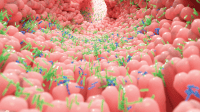Sue Franklin came to our facility for a routine cardiac catheterization after complaining of mild chest pain and shortness of breath. After the procedure, her physician used a vascular closure device (VCD) to seal the artery. Ms. Franklin did well, and she was discharged within 8 hours.
Her discharge instructions included reporting any swelling, pain, or bleeding. Her nurse also explained that the inserted device was a collagen plug, which meant her artery was artificially sealed; however, her body would take time to heal and eventually absorb the material.
Sounds routine, right? Well, 1 week later, she ended up in her physician’s office, complaining of shaking chills, a fever of more than 103º F (39.4º C), and redness and pain at the insertion site. She was hospitalized for I.V. antibiotic therapy and underwent two surgeries—one for debridement and one for reconstruction. Her stay lasted 3 weeks.
Although complications aren’t common with VCDs, they can be serious, as Ms. Franklin learned. And as all nurses should know, placing VCDs is an increasingly common procedure. The American Heart Association estimates that more than 1.2 million cardiac catheterizations and 664,000 percutaneous coronary interventions were performed in the United States in 2004. In 10% to 15% of these procedures, VCDs were placed to achieve hemostasis.
With numbers like that, nurses need to know all about these devices—how they work, how to care for patients with VCDs, and how to prevent and deal with complications.
Reviewing the types of VCDs
The first VCDs were used in the early 1990s to augment traditional manual compression. And the first type of VCD was, not surprisingly, a mechanical compression device. Since then, other types have emerged:
• Sutures close the arteriotomy site by approximating the edges of the vessel wall. They are used in the same tract as the access puncture site, though some require replacement of the original access sheath with a deployment device that enlarges the tract.
• Staples are usually extraluminal; they approximate the edges of the arteriotomy site, leaving behind a foreign body. With some, the staple edges expand to grab the external vessel wall and retract in the final stage, mimicking a “purse-string” stitch.
• Plugs may be placed intraluminally or extraluminally at the arteriotomy site. Materials include collagen, thrombin, and gelatin-based products. Some devices use a combination: Duett uses both thrombin and a collagen procoagulant material that is applied extraluminally; Angio-Seal™ deploys an absorbable anchor through the vessel wall, a collagen plug, and suture to sandwich the arteriotomy site.
• External patches use several means to increase coagulation at the puncture site, including using positively charged molecules to attract negatively charged red blood cells and using substances to accelerate the clotting cascade. After the femoral sheath is removed, the patch is applied over the puncture site, and manual compression is applied for 2 to 5 minutes.
• Ultrasound devices are one of the newer technologies. With the arterial sheath in place, ultrasound is used to observe the arteriotomy. Pressure is held while the sheath is removed, and ultrasound energy is directed at the vessel wall to denature the collagen within the vessel wall, which seals the site.
The ideal VCD would be easy to place, require a short learning curve, produce rapid hemostasis, and have a low complication rate. Limiting the types of VCDs used in a facility can simplify staff and physician training.
Because achieving hemostasis takes less time, patients experience less pain. This, in turn, means less time before walking again and a shorter length of stay. For these reasons and because hemostasis takes place in the catheter lab, nursing time decreases.
Common complications
VCDs have complication rates similar to those of manual compression. However, reports of serious and life-threatening complications prompted the Food and Drug Administration (FDA) to issue warnings in 1999 and 2002. Despite a good deal of research, including meta-analyses of random controlled trials and an FDA-sponsored analysis of a national database, researchers agree that more large-population, randomized, controlled studies must be done to determine the safety and efficacy of VCDs.
The most common complications are rebleeding, hematoma formation, retroperitoneal bleeding, arterial dissection, and pseudoaneurysm. Hematoma formation after the insertion of a collagen plug produces increased infection rates.
With manual compression, puncture site infection is rare, but with VCDs, the risk of infection is greater, and the associated morbidity and mortality rates are high. A 2005 study at the Mayo Clinic found 100% of the patients who developed infections after VCD insertion needed surgery: 54% needed reconstructive surgery, and 3 of the 46 patients died.
As with Ms. Franklin’s experience, many VCD placements are done as outpatient procedures, and the complications develop after discharge. Hematoma and pseudoaneurysm formation can develop days after the procedure, and the average incubation period for infections at the insertion site is 8 days.
Reducing complications
Keep in mind that a VCD shouldn’t be used for patients with double-wall punctures because the device will not close a puncture of the posterior wall. For patients who have received glycoprotein IIb/IIIa receptor inhibitors, the physician should weigh the risk of bleeding against the benefits of the VCD before insertion.
One Michigan hospital decreased the complication rate for VCDs from 6.5% to 2.5% in 9 months, using a method called Plan, Do, Study, Act. Their success resulted from collaboration among catheterization lab personnel, nurses, and physicians. Key tactics included the following:
• educating all team members
• using only one type of VCD
• using a specific continuous improvement process that includes checking for advances that require more education, tracking the quarterly complication rate data for each physician, and benchmarking national quality indicators.
So how can you help reduce complications? Educate yourself about the VCDs your institution uses. Be sure you are familiar with the most common complications, risk factors for complications, and the appropriate prevention strategies. Women, patients who have diabetes, and those who are obese have a higher risk of complications after VCD placement.
When new products are introduced, ask for information from the manufacturer and review your current policies and standards of care. If your institution has no guidelines or standards of practice for post–cardiac catheterization or interventional procedures such as angioplasty, be the one to initiate the process. Make sure everyone involved with VCD patients is educated and competent to provide care.
Nursing care after cardiac catheterization includes assessing the patient’s vital signs, input and output, and circulation in the groin area, especially the area below the insertion site. You should also monitor the patient for chest pain, shortness of breath, and discomfort.
Nursing protocols for postprocedure care should incorporate the manufacturer’s recommendations for bed rest and initial ambulation. Regardless of the method for obtaining hemostasis, assess the site before and after ambulation and teach the patient how to monitor for changes.
Patient teaching
Decreasing lengths of stay and increasing outpatient procedures mean patient teaching and discharge instructions are more important than ever. Be sure your patient understands that complications can occur several days after the procedure. Have your patient describe when and how to assess the access site and what to look for. Be sure the patient understands the importance of reporting changes immediately.
If your patient can’t see the access site, you’ll need an alternative plan. Depending on the situation, you can teach the patient to view the site using a mirror. Or, if the patient wishes, perhaps a family member or friend can perform this task. Keep in mind that family members and friends may not be comfortable with this task, so ask the person if he or she can assess the site.
When another person will be responsible for assessing the site, you should inspect the site together before discharge. Include basic instructions. Make sure the person knows to wash his or her hands before feeling a reddened site for warmth and to avoid touching the wound. If the patient can’t assess the site and no one is available to assist, notify the physician, who may arrange for nurse visits in the office or write an order for a home health consultation.
Nursing knowledge
Often, nurses are the primary caregivers after cardiac catheterizations and percutaneous coronary interventions, so you must know about VCDs and your role in patient care. Remember, your knowledge and your patient teaching can be the difference between a quick recovery and a serious complication.
Selected references
American Heart Association. Angioplasty and cardiovascularization statistics. Available at: www.americanheart.org/presenter.jhtml?identifier=4439. Accessed June 4, 2007.
Endovascular Today. Closure device update. Available at: www.evtoday.com/ChartsPDF/et0406_closure_chart.pdf. Accessed June 4, 2007.
Lins S, Guffey D, VanRiper S, Kline-Rogers E. Decreasing vascular complications after percutaneous coronary intervention: partnering to improve outcomes. Crit Care Nurse. 2006;
26(6):38-45. Available at: http://ccn.aacnjournals.org/cgi/search?sortspec=relevance&author1=lins&fulltext=&pubdate_year=2006&volume=26&firstpage=. Accessed June 4, 2007.
Sohail M, Akbar K, Holmes D, Wilson W, Steckelburg J, Baddour L. Infectious complications of percutaneous vascular closure devices. Mayo Clin Proc. 2005;80(8):1011-1015. Available at: www.mayoclinicproceedings.com/toc.asp?FID=55&issue=August%202005&folder_description=August%202005,%20Vol.%2080,%20No.%208. Accessed June 4, 2007.
Tavris DR, Dey S, Allbrecht-Gallauresi B, Brindis RG, Shaw R, Weintraub W, et al. (2005). Risk of local adverse events following cardiac catheterization by hemostasis device use—Phase II. J Invasive Cardiol. 2005;17:644-650. Available at: www.invasivecardiology.com/article/4937. Accessed June 4, 2007.
Donna Gibson, BSN, RN, is an E-Learning Specialist and Clinical Liaison at Lee Memorial Health System in Fort Myers, Florida.


















